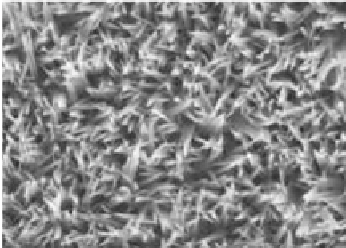Biomedical Engineering Reference
In-Depth Information
range of 60-100 nm and the length was in the range of 400-500 nm)
and investigated theirs bond strength [75]. They electrodeposited
calcium phosphate at 65°C from the 0.04M Ca(NO
3
)
2
+ 0.027M
NH
4
H
2
PO
4
+ 0.5M NaCl electrolyte. The deposition was carried
out by applying a constant potential of -1200 mV and by a two-
step process, of irst pulsing the potential between -1200 mV and
-200 mV for 60 cycles, and then applying a constant potential
of -1200 mV for a different time. During the potential pulsing
between -1200 mV and -200 mV, the potential of -1200 mV
was applied for 0.2 s in a cycle time of 10.2 s. At pH ~4, laky
type HA coating was observed (Fig. 9.81), whereas a hexagonal
columnar growth (crystals with diameter of 100-200 nm and 2 μm
long) was observed at pH ~6 (Fig. 9.82) [75]. Bond strength of the
coatings varied from 16 MPa to 19 MPa.
Figure 9.81
Flaky morphology of the calcium phosphate coating deposited
at -1200 mV. The pH of the solution was 4 [75].
Figure 9.82
Vertically oriented Ca-P crystals grown on the nanoporous
surface of the anodized Ti during a two-step electrodeposition
process. The pH of the solution was 6 [75].
























